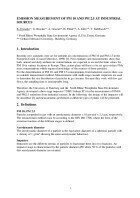Air Monitoring
EMISSION MEASUREMENT OF PM 10 AND PM 2.5 AT INDUSTRIAL SOURCES
Oct 06 2014
Author: K-J Geueke, G. Broeker, A. Gessner, H. Fißan, A. John and T. Kuhlbusch on behalf of CEM
1. Introduction
Recently new standards were set for ambient air concentrations of PM 10 and PM 2.5 in the European Union (Council Directive, 1999) [1]. First estimates and measurements show that both, annual and daily ambient air concentrations are expected to exceed the limit values for PM 10 at various locations in Europe. Thus, action plans will have to be set up to reduce PMx mass concentrations which requires knowledge of the sources of these particles.
For the determination of PM 10- and PM 2.5 concentrations from industrial sources there was no suitable measurement method. Measurements with multi-stage cascade impactors are used to determine the size distribution of particles in gas streams. Because they work with low gas flows, the sampling time is unacceptable long.
Therefore, the University of Duisburg and the North Rhine Westphalia State Environment Agency developed a three stage impactor (“GMU Johnas II”) for the measurement of PM10 and PM2.5 emissions from industrial sources. In the following the design of the impactor will be described [2] and measurements performed at different types of plants will be presented.
Digital Edition
IET 34.2 March 2024
April 2024
Gas Detection - Biogas batch fermentation system for laboratory use with automatic gas analysis in real time Water/Wastewater - Upcycling sensors for sustainable nature management - Prist...
View all digital editions
Events
Apr 22 2024 Hannover, Germany
Apr 22 2024 Marrakech, Morroco
Apr 23 2024 Kuala Lumpur, Malaysia
Apr 23 2024 Kintex, South Korea
Apr 23 2024 Edmonton, AB, Canada















